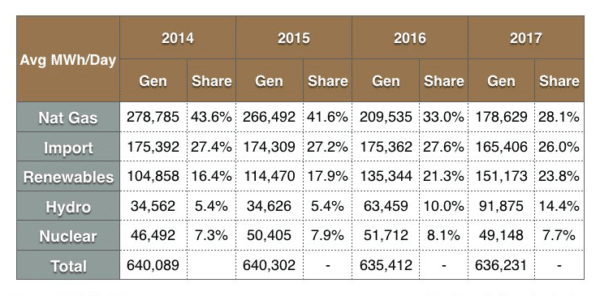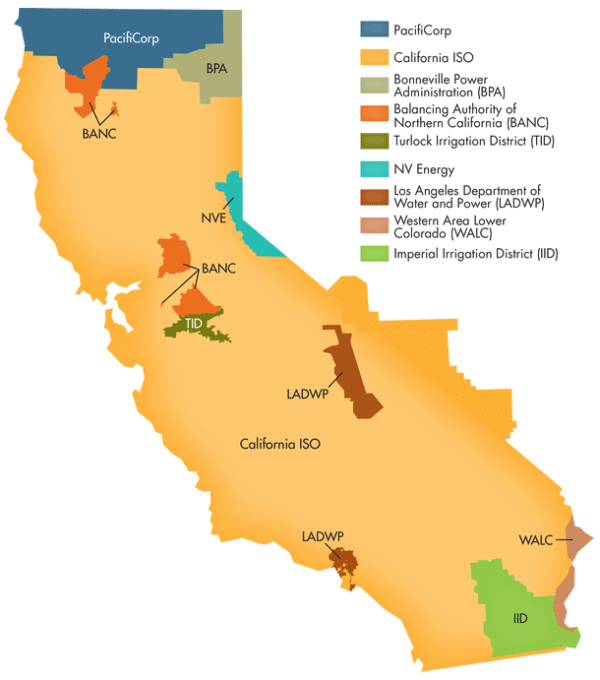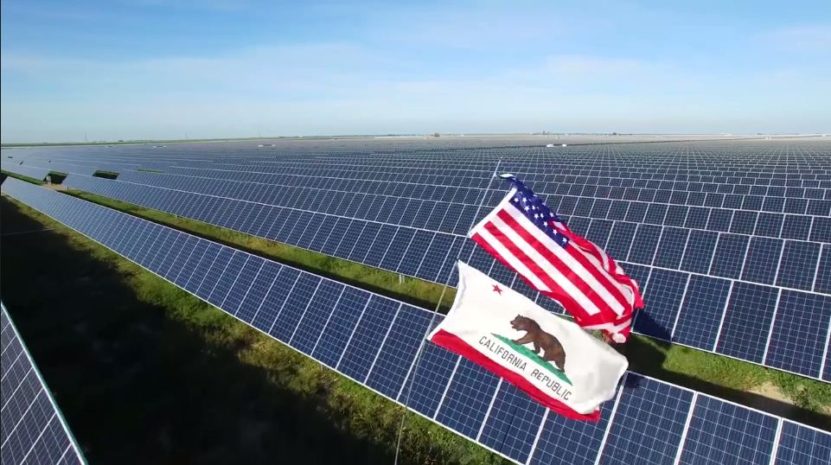Renewable energy continues to boom in California, surpassing even the state’s ambitious renewable portfolio standard (RPS) and breaking new ground on the issue of integrating large volumes of renewables.
The latest data from the California Independent System Operator (CAISO), as complied by Joe Deely, shows that RPS-compliant renewables met 24% of demand in the area managed by CAISO during 2017. This represented a 12% increase in raw output over 2016, and a 44% increase over 2014 levels.

Joe Deely
It is not clear at this time how much of the 24% of non-hydro renewables solar represented; however a report from the California Energy Commission indicates that for the state as whole solar was made up more than a third of non-hydro generation, which would put solar as meeting 8.6% of demand.
EIA data shows solar meeting 13% of demand in the state as a whole. Since CAISO does not count behind-the-meter rooftop solar (as EIA does), it is likely missing around 1/3 of the total solar generation in the state.
Another 14% of demand was met with large hydro plants within CAISO’s jurisdiction, bringing the total for the year to 38%. When nuclear is added in, 46% of demand was met with local sources that do not emit CO2.
There are a few details worth noting. CAISO’s governing area is not exactly the same as the state’s borders, so while the data shows the same trends as EIA data for California as a whole, it is not exactly the same. Additionally CAISO data shows not only sources of power within its jurisdiction, but also imports.
 Imported electricity levels dropped this year but still represented 26% of power on California’s grid. When you look at only local generation, more than half the kilowatt-hours generated on the CAISO grid were from renewable energy including large hydro. Along with these changes natural gas generation fell to meet only 28% of total demand, the third straight year of such decline.
Imported electricity levels dropped this year but still represented 26% of power on California’s grid. When you look at only local generation, more than half the kilowatt-hours generated on the CAISO grid were from renewable energy including large hydro. Along with these changes natural gas generation fell to meet only 28% of total demand, the third straight year of such decline.
The fall in gas generation is so significant in California that plans for new gas plants are increasingly being scrapped, sometimes to be replaced with battery storage. Such trends have begun to show on the national level, as during the first nine months of 2017 gas generation fell 11% in the United States, which may indicate that gas generation has peaked.
CAISO to become its own Reliability Coordinator
As California becomes a model of a new electricity paradigm based on renewable energy and energy storage, CAISO is also moving to become its own Reliability Coordinator. Yesterday the grid operator announced that it had given notice of its withdrawal from current reliability coordinator Peak Reliability as of September 2019.
Peak Reliability had been offering services to the Western Interconnection, however following the departure of Mountain West Transmission Group from Peak, CAISO says that costs had increased and its own membership no longer made sense.
Instead, CAISO plans to not only become its own Reliability Coordinator, but also to offer these services to other balancing authorities and transmission operators in the Western United States. CAISO plans to offer reliability services including outage coordination and day-ahead planning, in addition to real-time monitoring for reliability.
CAISO expects its new Reliability Coordinator unit to be certified and operational by spring 2019.
This content is protected by copyright and may not be reused. If you want to cooperate with us and would like to reuse some of our content, please contact: editors@pv-magazine.com.









By submitting this form you agree to pv magazine using your data for the purposes of publishing your comment.
Your personal data will only be disclosed or otherwise transmitted to third parties for the purposes of spam filtering or if this is necessary for technical maintenance of the website. Any other transfer to third parties will not take place unless this is justified on the basis of applicable data protection regulations or if pv magazine is legally obliged to do so.
You may revoke this consent at any time with effect for the future, in which case your personal data will be deleted immediately. Otherwise, your data will be deleted if pv magazine has processed your request or the purpose of data storage is fulfilled.
Further information on data privacy can be found in our Data Protection Policy.